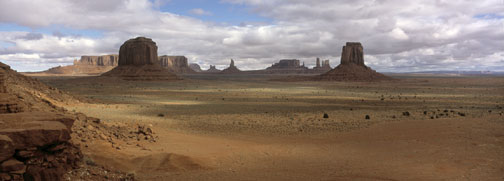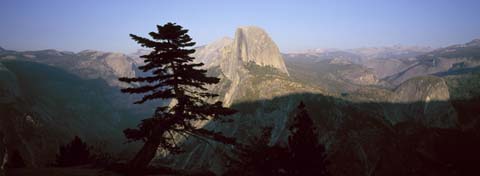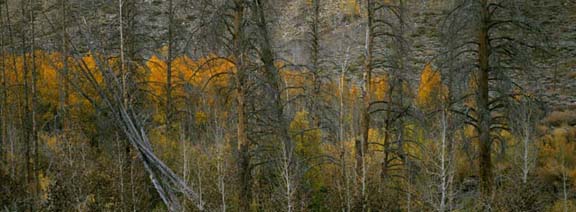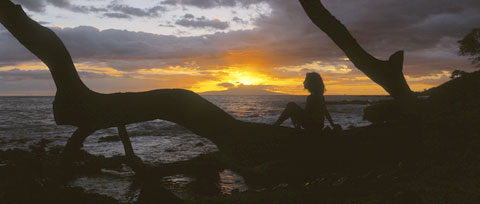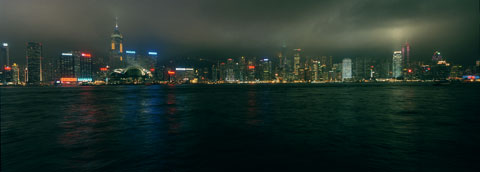This review originally appeared in the July / August 2000 issue ofPHOTO Techniques USAmagazine. The version below though is theoriginalmanuscript along with several updates, enhancements and with a number of more recent photographs taken with this wonderful camera system.
Note that in April, 2003 theXPan IIwas announced, with minor though useful updates.
Top Secret: Internal Eyes-Only
Date: December, 1996
Memo To: Product Development
From: International Marketing
We need to create a new market segment in the high-end and shake things up a bit. The camera equipment marketplace is saturated with SLRs and Point-and-Shoots. Leica has had the rangefinder market to themselves for decades. The Contax’s G1 and G2 have the automation features that consumers want but autofocus doesn’t appeal to a lot of high-end buyers.
Try and come up with a new interchangeable lens rangefinder system that has TTL metering, optional auto-exposure, motorized advance and rewind. The body should be extremely rugged and have top quality materials and construction. How about using titanium?
Oh yes, one more thing. Any way to make it panoramic? APS users love panoramic mode and our market research shows that high-end users also find wide-format appealing. Right now only the Noblex 135 and the Mamiya 7 (with wide-format 35mm adaptor) are out there using 135 film. We could really carve a strong niche with a camera that could shoot both regular 35mm and double-width panoramic. We also think that we can get one of the big European manufacturers to market it internationally. See what you can come up with.
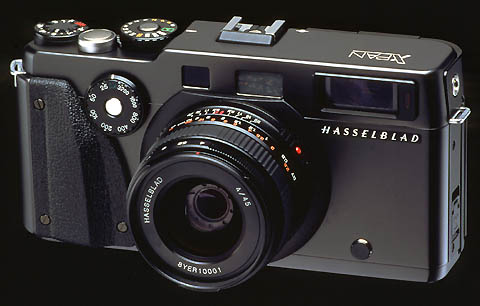
The Dream Come True
Recipe for an exciting new camera system. Imagine a cross between aLeica M6,Contax G2and aNoblex 135. Take some of the best features and capabilities of each, stir, and mix into a rugged titanium body made byFujiin Japan and sold there as theTX-1, but sold everywhere else in the world as aHasselblad. You¹ll then have the uniqueXPan, an interchangeable lens 35mm rangefinder camera system with true panoramic capability.
Introduced atPhotokinain September 1998, the XPan was in high demand and short supply until well into mid-’99. Even so, it is a niche market camera designed for a market segment that didn’t exist before its introduction. In an era of mass-market consumer products, a new high-end specialty camera is a rarity. Yet, the XPan is so well conceived that one wonders why no one tried it before.
If you are familiar with M series Leicas you’ll feel right at home with the XPan. It’s wide and somewhat heavier, but handles similarly. Within this remarkably compact body are found auto-film-load, motorized advance and rewind, as well as aperture-preferred auto-exposure or match-diode behind-the-lens metering.
The XPan has a reasonably bright co-incident image bright-line focusing viewfinder. Not quite as bright as a Leica¹s, but better than that of the Contax G1 and G2.
The real differentiator of the XPan over any other camera is its dual personality. With the flip of a switch this mild-mannered 35mm RF camera becomes a super-35, taking a true panoramic double-width frame of 24mm X 65mm; exceeding the actual frame width of even a 6X7 camera frame! I describe it as true panoramic because unlike APS cameras, for example, which create a panoramic mode by cropping the existing frame to a wide format, the XPan actually doubles the width of the film exposed. When the format switch is flipped a motorized blind is expanded and the viewfinder frame lines are adjusted appropriately.
I’ve been a rangefinder camera aficionado since the 70’s when I used Leica M2s and M3s while working as a photojournalist. While the siren song of autofocus SLRs has won me over for much of my current 35mm photography, viewfinder based camera have always been part of my equipment arsenal‚ most recently a Leica M6 and, experimentally, both the Contax G1 and G2. For travel and documentary work the compactness and simplicity of a RF system can’t be beat. But, my other love is panoramic photography. I find that I often see the world with a wide-screen eye and either aFuji 617orNoblex 135has usually been part of my travel kit. But, with the XPan I am able to combine in one camera many of the capabilities that I require for travel photography‚ compactness and lightweight, RF focusing, and a panoramic format on demand.
Since purchasing mine in the winter ofɉ۪98 I have used it on my travels in Barbados, the UK, France, Hong Kong, Bali and Rumania, and a number of locations in the southwestern United States. I have never traveled with a camera that I have found as suitable for travel, casual landscape and documentary work as the XPan.
Taken with a Hasselblad XPan and 90mm lens on Provia 100. I had received the camera just a few days prior to a winter vacation on Barbados. This frame was taken on the first morning there on the first roll of film ever shot with the camera. Click on the picture to see a larger version. It’ll make you smile. (Use the browsers BACK button to return here).
Processing and Printing
One serious issue for anyone considering purchasing an XPan is that of making prints. A roll of transparency film with even just one XPan frame on it should be handed in to the lab with a request that it be processed only. No mounting. If you do your own printing or scanning you can then handle the filmstrip the way you do negatives. If you shoot negative film then this isn’t an issue, but in either event making prints is.
If you do your own printing then all that’s needed is a medium or large format enlarger and a variable or 6X7 negative holder. It¹s fairly simple to make a cardboard mask. If you use a digital darkroom system and do your own scanning then just about any 35mm scanner that has a filmstrip holder will do the job. Just cut away one of the plastic frame dividers and scan the left and right halves of the image separately, using your imaging software to merge the two parts afterward.
Unfortunately, whether you shoot color or B&W, transparencies or negatives, if you have prints made by a photo lab you’ll end up paying custom rates because the XPan’s film size is non-standard. Thereareslide mounts available fromThe Stock Solutionin Salt Lake City, and if you have a 6X7 projector they¹ll look truly spectacular on a large screen.
I waited almost half an hour for the clouds to produce just the right pattern of light and shadow on the valley floor below this perspective from the North Window inMonument Valley. If ever there was a scene worth of being called aLuminous Landscape, this is it.
If you click on the image above you will see, as usual, a slightly larger version. But, if you have a fast Cable or DSL modem (or a lot of patience) you may clickhereto view a version that’s 18" wide!
Photographed with a Hasselblad XPan and 30mm lens on Provia 100F
Handling
The logical cameras for comparison are the Contax G2 and Leica M6. In terms of automation the XPan is similar to the G2, but without autofocus. Otherwise, it’s similar to an M6 in being a true rangefinder camera. While there¹s no denying the quality of the Contax and its superb Zeiss lenses, in many ways it’s a glorified point-and-shoot with an uninspired viewfinder. The M6 is therefore one of the only other true 35mm rangefinder camera in existence, and looking through one and taking photographs with it is an unalloyed joy. But, though not as bright as the Leica, and therefore somewhat more difficult to use in low light levels, the XPan¹s rangefinder is accurate and pleasurable to use.
Film loading is straightforward, and automatic film advance and rewind are smooth and relatively quiet. It’s not a stealth camera like an M Leica, but in normal circumstances it’s unobtrusive, in part because its winding motor sounds are low pitched. Lens changing is as precise as one would expect from a quality camera. Single frame or continuous exposure settings are available
The XPan features several welcome automation features, including automatic 3-frame exposure bracketing, with either half or full stop increments. Other welcome touches include provision for eyepiece diopters, and automatic +/- 2 stops exposure compensation.
Normal and panoramic exposures can be mixed freely. The camera uses micro-motors to move the film, film gate and viewfinder frames each time the format adjustment switch is activated. Interestingly, when a roll is first loaded the film is withdrawn completely from the cassette. This allows the film to be precisely positioned regardless of how often format framing is changed. An added advantage is that if the back is accidentally opened no exposures will be lost — only unexposed film. Because of this the frame counter displays frames remaining, rather than frames exposed and this changes dynamically depending on which position the frame selection switch is set to.
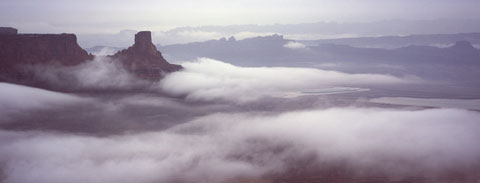 Clouds Under Dead Horse State Park, 2000
Clouds Under Dead Horse State Park, 2000
On a mid-winter shoot at several of the National Park inSouthern Utahin January, 2000 I had brought along the XPan as a supplement to my usual Rollei 6008i medium format system. Because of the nature of the landscape I ended up shooting more film with the panoramic Hasselblad than I did with the Rollei.
Photographed with a Hasselblad XPan and 90mm f/4.0 lens on Fuji Provia 100 F.
In October ’99 I was shooting inYosemite National Park, mostly with a Rollei 6008 system. I did a bit of shooting that day with the XPan and 45mm lens as well. Some of the results, such as this image, I prefer to the medium format work that was produced at the same time.
Flaws
The camera has one serious, though not quite fatal flaw. This has been commented on elsewhere and it’s hard to believe that the camera was put into production with such a glaring omission. I¹m referring to the lack of shutter speed information in the viewfinder. The LCD on the back panel displays the shutter speed when the release button is partially depressed. But, when in aperture priority mode you will have no idea of what speed the camera is selecting unless you remove the camera from your eye, hold it at arms length (to see the LCD) while point at the subject and then decide if the speed is appropriate. As a consequence I avoid exposure automation and use the camera in match diode mode by adjusting the aperture manually after first setting the shutter speed according to the shooting situation. Regrettably, in bright light the LEDs are washed out and difficult to see clearly. Hopefully the next iteration of this design will address this combination of shortcomings.
Also widely discussed is the stiff and awkward control used to switch between normal and panoramic mode. While it makes the risk of accidentally switching modes almost non-existent, it certainly could be reengineered to be more convenient. Notwithstanding these issues and recognizing that no camera is without its design flaws, particularly in its first iteration, the XPan remains a pleasure to use and is capable of outstanding image quality.
Lenses
There are three lenses currently available; a 30mm, 45mm and 90mm. (In panoramic mode these are equivalent in coverage to roughly 15mm, 24mm and a 50mm respectively, in terms of horizontal coverage). They are also no larger than lenses one would expect to only cover the 35mm format. Considering that they are capable of covering a frame 65mm wide‚ as wide as that from a 6X7 camera, their small size is nothing short of remarkable. This is achieved by limiting maximum aperture to f/4.0; (f/5.6 for the 30mm) a small price to pay for their compactness.
As for image quality, it’s nothing short of superb. I have made 13X19" prints that easily rival medium format quality. In fact, the camera when used in panoramic mode produces negatives that are the same size as medium format — just skinny ones.
On a negative note, the 45mm lens, when used in panoramic mode, exhibits slight vignetting. This can be eliminated through the use of aHasselblad 54453 Center Filter, orcorrected digitallyinPhotoShop. But, for many images, unless there is a large expanse of white sky, the filter isn’t usually necessary. The 30mm requires a center filter at all times and in this case it is supplied with the lens rather than being optional.
It should be noted that the lenses have been designed and manufactured byFuji, as is the camera body. Like most Fuji lenses in my experience they are remarkably sharp and free from flare.
A separatereviewof the ultra-wide 30mm lens is also available.
Route 168in the Eastern Sierras is one of the great roads in California for fall colour. I found the contrast between the foreground dead trees and the aspens in the background very appealing. A 18" wide print from this XPan transparency, shot with the 90mm lens, is astonishing in its detail.
Quality
No review of a camera would be complete without a discussion of that difficult to quantify trait that lovers of fine equipment recognize immediately — build quality. The XPan has it, in spades. The body has heft, yet is well balanced. The lens mount is positive and smooth, and the camera simply feels all-of-a-piece. The partially rubberized titanium body is comfortable to hold in the cold as well as when ones hands are hot and sticky. The Hasselblad XPan provides its owner with the tactile satisfaction of a high quality instrument. It feels like it will last forever.
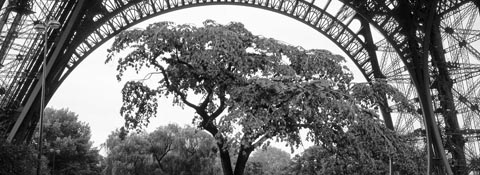 Tree & Eiffel Tower, Paris 1999
Tree & Eiffel Tower, Paris 1999
On a trip to Paris in October ’99, I was wandering along the Seine one rainy afternoon and ended up at the Eiffel Tower. A suitable subject indeed for a wide-format camera (if you like long verticals — which I don’t). I walked beneath the tower admiring its architectural grace and came across this wonderful old elm tree, whose canopy matched the arch of the girders almost perfectly.
I decolorized the image in Photoshop. The photograph works much more strongly in black and white than in colour. Because I scanned the original transparency with thePolaroid 4000scanner at 4000 PPI, an 18" wide print is still 550 PPI at this size, providing a wealth of detail. You can actually count the rivets in the girders, the lens is so sharp.
Taken with a Hasselblad XPan and 45mm lens on Provia 100.
Scanning XPan Film
Digital darkroom owners will need to do a bit of work to handle wide-format XPan images. Your scanner¹s filmstrip holder should have one of the dividers trimmed off. An X-Acto blade does a good job. Just be sure to smoothly sand down any rough edges.
Scan first the left and then the right side of the frame. Be sure that you overlap the scans slightly so that a bit of the right side of the left scan and the left side of the right scan overlap. Next, load both halves into a program such as ArcSoft’s PhotoStudio. This particular program has a Stitch function which seamlessly merges two images. Use a blend of 0.
Be aware that the merged file will very large. With a 2700dpi scanner you’ll end up with a 50MB file and with a 4000dpi scanner like the Polaroid or Microtek the file will be about 100MB in size. You need between 256 and 512 megabytes of RAM to handle files that large.
Hereis an additional brief tutorial on how this can be done simply with current generation scanners.
When I travel on vacation rather than on a photographic trip per-se I now always take the XPan and its 3 lenses. The whole kit fits in a very small shoulder bag and weighs almost nothing. A table-top tripod fits in the bag as well and allows me to handle early morning and sunset shots.
This photograph of my wife is an homage to the countless cheesy Hawaiian postcards showing a woman silhouetted against a glowing sunset sky. How could I resist?
Photographed with a Hasselblad XPan and 90mm lens on Fuji Sensia II
UPDATE:Nov, 1999
Hasselblad has finally announced the long-awaited30mm ultra-wide angle lensfor the XPan. It is an f/5.6 and comes with an accessory viewfinder that mounts onto the flash shoe. It couples to the rangefinder system for focusing.
Using the panoramic 24 X 65mm frame it covers a remarkable 94 degrees. Since this format has the same film width as a 6X7 camera, this lens has the honour of being the widest angle rectilinear lens available for any medium format camera. The Mamiya 7 wide angle is a 43mm, by way of comparison.
This lens is reported to be ready to ship some time in January 2000. The street price will be something under USD $3,000. I have one on order and will report on it in detail as soon as I’ve had a chance to spend some time with it.
UPDATE:Feb 17, 2000
The 30mm lens has started shipping and mine has just arrived.My reviewis now on-line.
UPDATE:March 5, 2000
I have just returned from a trip to Asia, where I had an opportunity use the 30mm lens in the field for the first time.A portfolioof photographs, all taken with the XPan system, and most taken with the 30mm lens is featured in this new section.
My first day in Hong Kong was cool and rainy. After an afternoon nap to help recover from jet lag I was eager to try out the new 30mm lens. As night fell I walked along the promenade on theKowloonside ofVictoria Harbour, and using a small table-top tripod on the edge of the sea-wall took this 8 second exposure @ f/16. The rain and mist helped add some character to the sky.
Photographed with a Hasselblad XPan and 30mm f/5.6 lens on Kodak VC400 film.
UPDATE:March 11, 2000
I have just become aware of a recentlyre-published reviewof the XPan by British journalistDavid Kilpatrick. It contains some interesting information about the system that I had not encountered elsewhere. David also confirms the rumour, which I have heard as well, that Hasselblad will announce a 135mm lens for the XPan some time this year.
UPDATE:March 30, 2000
I am not a fan at all ofEvereadytype cases for cameras. But, some folks do like them andKameraleder Los Angeleshas just announced such as case for the XPan.
Update:September 29, 2000
I have now been using the XPan extensively for about a year and half. Though I have and use many fine camera systems it remains one of my favourites, especially for personal travel and for extensive hiking.
I have been negligent in adding links here to many of the portfolios that I have created using this system. But, browsing the site for a while will certainly turn most of them up.
I’d like to draw your attention though to a section calledAppalachian Adventure, which as this is being written is at its mid-point. In particular have a look at the section calledBrasstown Baldwhich has some striking mountainscapes shot with the XPan.
Update:December 24, 2000
Here isa comparisonof the coverage provided by the three lenses currently available for the XPan.
Update:January 11, 2001
I am now using powerful stitching software to turn the XPan into the equivalent of a 6X7cm camera.Here’swhat I do. I have also prepared a small portfolio from theBlue MountainsofJamaicataken with the XPan.
Hasselblad has announced theXPan II, a minor but long overdue update to theXPancamera body. The major new features are shutter speeds visible in the viewfinder (finally — thank you), and an electronic remote release. These and the other new features are…
LCD display in the viewfinder showing shutter speed and exposure information
Multi exposure (up to 9 exposures)
Self-timer delay 2 or 10 s
B-time 540 s
Improved IR film performance
Flash sync at the beginning or end of exposure
Rewind of film with option to leave a film tip out of the cassette
Lens shade for 45 and 90 mm lenses with locking device
Diopter lens with locking system
Electrical remote release (optional release cord)
You May Also Enjoy...
Saguaro National Park
I can easily understand why it should puzzle you that a person of my intelligence, I.Q. 207 super genius, should devote his valuable time chasing
